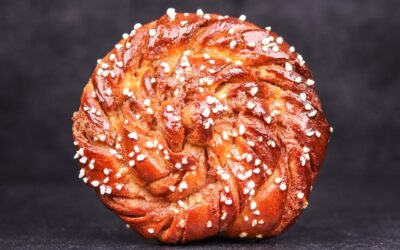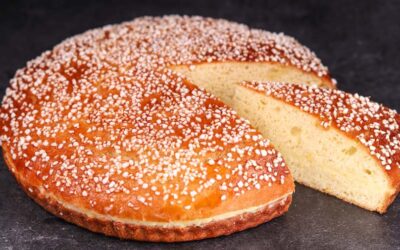This once again proves that brioche is the most versatile dough. There are countless recipes you can use it for. And why not try and make super rich custard filled steamed buns with it!
As of now I have two brioche recipes. One made with a mixer, and another kneaded by hand. So, finally everyone can make it.
The 6 buns in the video require half of my standard brioche dough. I normally make a double batch so that I can use it for two projects. If you would like to use the whole dough and make 12 buns, then you must also double the ingredients for the custard.
A steamer is essential for this recipe. You can use a metal or a bamboo steamer. Another piece of equipment that will come in handy is a silicone pastry mould. Or anything that is small and flexible so that the custard can be frozen into portions and easily removed for use. Silicone muffin moulds could also be used.
Watch the video down below for detailed instructions.
Ingredients
For the custard –
200g (7oz) whole milk
50g (1.75oz) egg yolks
70g (2.45oz) sugar
30g (1oz) corn starch
7g (0.25oz) vanilla paste, syrup, essence, or half of a vanilla bean
For the dough –
500g (1.1lb) white bread flour
45g (1.6oz) water
250g (8.8oz) eggs
13g (0.45oz) salt
60g (2.1oz) sugar
8g (0.28oz) instant dry yeast or 9.6g (0.33oz) active dry yeast or 24g (0.84oz) fresh yeast
150g (5.3oz) butter
To learn more about dough temperature control click here.
Method
- Make sure all the ingredients are cold!
- In a large bowl combine the eggs, water, yeast, salt, and sugar. Mix well to dissolve the salt and sugar. Add the flour and mix to a dough. Tip the dough out on the table.
- Knead for 10 minutes. It will stick to the table and to your hands. Use the dough scraper to scrape the dough together occasionally and continue kneading. The dough will still be quite sticky after the 10 minutes. This is due to the eggs and sugar.
- Stretch the dough out and add the butter. Fold the dough around the butter. Press and squeeze the dough for at least one minute. Try and force the butter into the dough.
- Once the butter has been incorporated continue kneading the dough using the stretch & fold method. This stage will take 15 minutes. Don’t get discouraged because of the length of time. The stretch & fold is far easier than the initial 10-minute mix. It is quite therapeutic and pleasant. *Desired dough temperature 25C – 26C (77F – 79F).
- Place the dough in a bowl, cover, and chill for 1 hour.
- Fold.
- Cover and chill for 1 more hour.
- If you want to use the whole dough for one project, then leave it as it is. If you want to use it for two projects (like I do and suggest), then divide it in half and shape the two halves in balls.
- Wrap in clingfilm and cold ferment for up to 24 hours. You can leave it to ferment for longer too. I used the second dough ball after 48 hours and it worked just fine.
- Make the custard. Combine all ingredients in a small pan. Cook over medium heat stirring occasionally until the mix starts warming up. Once the mix gets warm whisk it continuously to prevent it form sticking to the bottom of the pan. As soon as it becomes thick turn the heat off and continue whisking and stirring for another 30 seconds. The total cooking time should not exceed 8 – 9 minutes.
- Divide the custard into equal parts in silicone moulds. Freeze.
- Divide the dough into 6 equal pieces. Pre-shape.
- Rest for 45 minutes.
- Flatten the dough into a small disc and roll the sides flat. Place a piece of frozen custard on the dough and fold the dough around it. Seal it up and repeat with the rest of the dough balls.
- Place on a perforated piece of non-stick paper. Cover and ferment for 4 – 5 hours. The final proofing time will depend on the temperature of your kitchen. You can place the dough in a warmer area to speed it up.
- Place the steamer over a pot of boiling water, cover and steam the buns for 15 minutes.
Leave to cool down slightly and enjoy!
Keep in mind that the conditions in each kitchen are different, so fermentation times may vary for you. It is up to the baker to control the bread and react accordingly.
Your oven may be different too, so your baking time may vary.
Watch the video here



